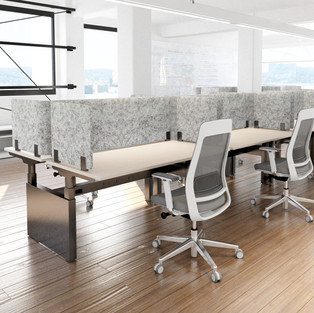What the Future of the Workspace Will Look Like After COVID-19
- Jeff Blue

- May 18, 2023
- 4 min read

The workplace has undergone tremendous changes over the last several decades, but the impact of COVID-19 may be the most dramatic transition yet. And even though not everyone is immuned to the worldwide pandemic, we are still expected to sit at a desk and work.
So how do we return back to work safely? We will discuss both short-term and long-long term solutions to help workspaces transition into safe, healthy and workable environments.
Benching + Open Office
Benching and open office environments fill a large portion of our workforce landscape worldwide. From limited space to privacy issues, current trends indicated the need for change. And what once was constantly resisted by organizations is now the foundation to survival and innovation.
We can say so long to working shoulder to shoulder, because thanks to COVID-19, proper social distancing and hygiene is key to control the spread of this virus and the many to come in our future.
Benching and workstation solutions will now be more spacious, with fewer individuals at each station/bench.
Privacy screens between each individual will also be required to prevent the spread of germs that can linger from coughing and sneezing. These screens will also set and enforce the boundaries needed to remind us to keep our distance from our working friends.
Don't forget to consider the surfaces and materials in these well-used spaces. While felt or fabric panels are a better solution, acrylic and glass screens/dividers are the best due to their cleanability.

Sanitation Stations
Speaking of cleanability, to help control the spread of germs we highly recommend investing in sanitation stations and placing them strategically throughout the workplace. Sanitation stations come in a variety of options. They can be fully loaded stations that hang on a wall with hand sanitizer, gloves, masks and disinfectant spray. Or they can be as simple as a table with disinfectant wipes and hand sanitizer. Regardless of how you set up these stations, it is what you supply and where you locate these stations that is important.

Key areas to consider:
near workstations and benching systems
in break rooms near items that are often used by others
hallways
conference and meeting spaces
training rooms
collaborative spaces
any shared space
libraries
entrances
restrooms
Conference Rooms + Meeting Spaces
Out with the old, in with the new. The old way of maximizing the number of seats inside a conference room is OUT. As we continue to practice social distancing, removing any excess seating is a start, but don't stop there. Making these spaces less dense is key and will require removing approximately 1/2 of the seats around the table.

Collaborative Spaces
Don't worry, collaborative spaces aren't going away. But they are transitioning. Here's how:
Much like conference and meeting spaces, the seating areas need to be less dense and more spacious.
Adding space dividers and floor decals to establish proper social distancing is a must.
Removing items that are difficult to disinfect, such as decorative throw pillows and lumbar pillows.
Provide easily accessible sanitation stations
Invest in advanced, "smart" and "on command" technology to reduce the amount of shared tools
As we design for the future, these spaces will likely be designed with cleanability and sanitation as the focus versus comfort.

Lounge Areas
Much like collaboration spaces, lounge areas will also transition. The types of seating and how they are cleaned will be a high priority. This is also true for side tables and occasional tables.
Seating that allows individuals to create space between one another is key. But if you are not in the market for new seating furniture, then properly spaced seating will work just fine. Creating visual boundaries with floor decals will also help individuals practice safe distancing.

Break Rooms
For highly-used shared spaces, like a break room, having furniture that can be easily cleaned and sanitized is optimal. Plastic stacking chairs are easily wipe-able and can withstand harsher cleaning solutions.
Space is also important in this area. If your break room has multiple tables, consider condensing your furniture and removing any excess seating to allow for safe distancing.
Provide sanitizing solutions for hands and surfaces. We also encourage displaying proper signage about hygiene and cleaning protocols.

Air Quality
One main factor that lead to China's success after reopening businesses is their indoor air quality due to high-end air filtration systems. China has made indoor air quality a top priority for years now, and thankfully it has paid off.
Since the widespread of COVID-19, having poorly ventilated buildings will now become a key component for change in the US. Virus's can live for days on surfaces and up to 3 hours in the air. Having a quality filtration system will now be the new workspace amenity that every dream-office will have, and it just may become a deciding factor when it comes down to the safest place to work.
You can improve office air quality by investing in high-end filtration systems (which we expect to be more common in new buildings going forward) and purifiers, but these can be costly.
However there are less expensive ways to help improve air quality (keep in mind that the best solution will be investing in a purifying filtration system):
adding smaller purifiers throughout the office
if you have access to fresh air, open windows and doors every once in a while
adding air purifying plants throughout workspace
















Comments